

Table of contents
- Potato scab - unsightly but controllable
- Can you still eat infected tubers?
- Identify potato scab
- The cause is bacteria living in the soil
- This is how the tubers become infected with potato scab
- prevent and combat
- Overview of hardy varieties
- Potato blight threatens the harvest
- Identify potato blight
- It is caused by a common fungus
- Cool and damp weather favors infection
- As follows from late blight
- prevent and combat
- Overview of hardy varieties
There are around 5,000 different types of potatoes worldwide, which differ significantly in appearance, shape and taste. However, you won't find these delicious rarities in the supermarket; instead, you can grow the tubers in your own garden. However, to ensure that your harvest is not threatened by common potato diseases such as potato blight or potato scab, you should take effective countermeasures before planting.
Potato scab - unsightly but controllable
Potato scab is a common but harmless plant disease. The characteristic, scabby patches develop as a defense reaction of the potato plant against attacks by certain oxygen-loving bacteria living in the soil. Basically, these are scarred wounds that appear on the tuber skin and represent a purely visual defect. Yield, taste or germination are not affected by potato scab. Only the increased peeling waste can be annoying, depending on how deep the scab has penetrated the peel.
Can you still eat infected tubers?
Potato tubers with scabs are safe to eat, just cut out the scabbed parts.
Tip:
The easiest way to do this is to cook the infested potatoes like jacket potatoes and only peel them once they are cooked. The scab comes off completely together with the shell.
In principle, it is also possible to use infested potatoes as seed potatoes, since the causative bacterium cannot survive on the potato skin but only in the soil. A reinfection through scabbed tubers is therefore not possible. However, experts advise against using it because the disease can easily be confused with other contagious potato diseases. This is the case with fungal diseases such as those caused by the Phytophthora fungus.
Identify potato scab
Potato scab can only be recognized at harvest, since only the tubers are affected and nothing can be seen on the herb itself. Infested potato tubers are identified as warty, brown, and cracked spots that may coalesce into larger, cohesive patches in more extensive infestations. As a rule, the scabs are superficial and penetrate only a few millimeters into the pulp. However, sometimes the scab sinks deeper into the tuber like a crater, in which case the specialist speaks of so-called deep scab.
These forms of potato scab are distinguished:
- Flat scab: flat, pustule-like infected areas on the tuber
- Humpback scab: pustular infested areas are raised on the tuber surface, with the formation of new tissue underneath
- Deep scab: infested areas sunken into the tuber like a crater
Potato tubers with flat scab and humped scab cause only slightly more waste Peel as healthy potatoes, but when scab develops you often have to do a lot cut away. In this case, the jacket potato method described above to avoid peeling waste cannot be used either.
Tip:
Deep scab occurs only rarely, but experience has shown that it occurs mainly on late potato varieties.
The cause is bacteria living in the soil
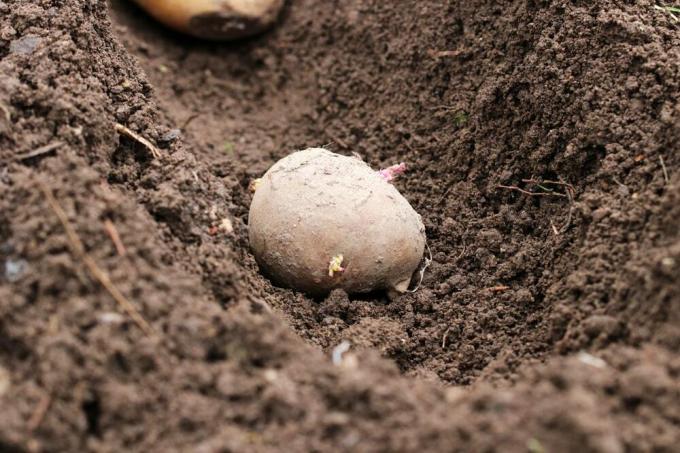
Causes of potato scab in the soil-dwelling, aerobic bacterium Streptomyces scabies. It is dependent on the supply of oxygen from the air, which is why the disease mainly occurs when growing on loose, permeable and sandy soils. Does this also contain a large proportion of non-rotting organic material - which, for example, is included in fertilization stable manure is available - and if the weather is rather dry for weeks, Streptomyces scabies finds perfect living conditions before.
This is how the tubers become infected with potato scab
These circumstances are particularly dangerous when the potatoes are in bloom. At this point, thick growth begins, with the skins of the still young tubers being tender, thin and therefore very susceptible to the penetration of a harmful fungus such as Streptomyces scabies. Potato scab always develops at the time of tuber formation, which is why preventive measures should be taken before or after the tubers are formed. are in effect at this time. Once the tuber's protective barrier – which is ultimately the skin – has been penetrated, potato scab can no longer be combated.
An overview of the formation conditions for potato scab:
- well-aerated, loose, well-drained soil
- (sandy) soils with pH values above 5.5
- Soils with high proportions of non-decayed organic materials (fresh manure, roots...)
- Drought and high temperatures at the time of the potato blossom / tuber formation
prevent and combat
Since active control in the current gardening year is no longer possible once potato scab has appeared, you can only rely on preventive measures. This includes making life as difficult as possible for the bacteria by interrupting the oxygen supply:
- Do not lime the soil before sowing / in the year before sowing
- Do not plant potatoes on newly dug grassland
- Do not dig up the soil just before sowing
- Dig up the soil in the previous autumn
- undermine well-rotted compost or manure
- Incorporation of powdered rock with a high silicon content
- do not use fresh manure or half-rotted compost!
- green manure with phacelia or mustard also prevents
- Pile up the potato plants well / chop them a little
- Irrigate potatoes when dry
Tip:
It can also help to keep the pH of the soil as low as possible through targeted fertilization. Sulfuric acid ammonia or manganese sulfate, for example, is suitable for this.
Overview of hardy varieties
The use of largely resistant potato varieties is also effective against potato scab:
- ,Auditorium': late, mealy variety, also resistant to potato blight and other diseases
- 'Birgit': medium-early variety resistant to scab and other potato diseases
- 'Clivia': medium early, mainly waxy, high resistance to scab and other diseases
- 'Dunya': medium early, mostly firm
- 'grata': medium early, waxy, high resistance to scab and other diseases
- 'hela': early variety, mainly waxy, high resistance to scab
- 'Palma': medium early, mostly firm
- ,Fine': early variety, mainly waxy, high resistance to scab and other diseases
- 'Revelino': early, waxy variety, high resistance to scab and other diseases
Tip:
Pre-germination before actual sowing has also proven beneficial in avoiding potato scab.
Potato blight threatens the harvest
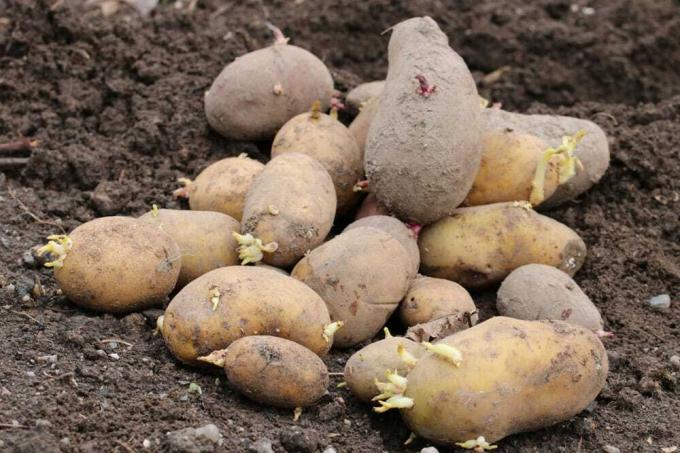
Potato blight – often referred to as brown rot or late blight – is one of the most common fungal potato diseases. The cause is the same fungus that causes late blight on tomatoes. It is a serious disease that can cost even amateur gardeners a large part of the harvest and is, among other things, the main cause of the Great Famine in Ireland in the 19th century. Century applies. About a million people died here, another two million saved themselves by emigration. Today, however, another pathogen is in circulation, which came to Europe from Mexico in the 1980s and is considered to be more aggressive.
Identify potato blight
The first symptoms of potato blight can already be seen on the stems and leaves of the potato plant. Dark brown spots quickly spread here, starting from the edges of the leaves. These increase very quickly, especially in damp weather and heavy dew formation. Typically, a fungal turf forms on the underside of the leaf, which looks similar to a mold covering.
Here are the so-called spore containers, from which the spores spread when wet. In addition, they penetrate deep into the plant tissue and attack not only the above-ground parts of the plant, but also the tubers. Here, an infestation is shown by grey-blue discolored spots on the shell, while the inside becomes brown and inedible.
Once brown rot has attacked the tubers, they can no longer be eaten. It is also not advisable to use them as seed potatoes.
It is caused by a common fungus
Potato blight is caused by the fungus Phytophtora infestans, which overwinters in stored potato tubers. If these are used as seed potatoes, infection of the entire crop is likely. The fungal disease occurs when the humidity is high (at least 80 percent) or damp / rainy weather and temperatures between eight and twelve degrees Celsius are ideal growing conditions.
Cool and damp weather favors infection
At ambient temperatures of more than 21 degrees Celsius, however, the fungus does not develop further. An epidemic that destroys entire potato stocks over a large area is not unlikely due to the special form of propagation: the fungus reproduces both sexually and asexually, and numerous germinating spores are widely dispersed by wind and rain. The mating types necessary for sexual reproduction are now represented in almost every potato-growing country.
As follows from late blight
Initially, the disease is limited to the herb; the tubers are usually infected during harvest through contaminated soil, dirty equipment or diseased parts of the plant. Heavy rain can also spread the disease into the tubers, washing the spores out of the herb into the soil and onto the potato tubers.
prevent and combat
Copper sprays are particularly suitable for acute combating of potato blight in the home garden. However, treatment with copper hydroxide is only effective early in the infection and should therefore be started as early as possible. On the other hand, if the remedy is applied too late, it no longer helps. Instead, you can also spray preventively, which is especially important if the potato blight has already occurred in the same place or in a neighboring garden. Furthermore, plant strengtheners help to support the immune system of the potato plants. In particular, horsetail and sage extracts as well as rock flour have proven to be effective here.

The best way, however, is to take preventive measures that prevent potato blight from developing in the first place:
- Only use healthy seed potatoes!
- Pregerminate seed potatoes and plant out early
- Avoid over-fertilization, especially with nitrogen
- prefer organic fertilizers such as mature compost or rotted manure
- Mulch the planting area well, e.g. B. with lawn clippings
- keep a generous planting distance
- Do not leave any potatoes that have been sorted out during harvest
- Do not plant tomatoes and potatoes next to each other
To avoid infection of potato tubers during harvest if blight is present, Only dig them up after the herb has completely died off – at the earliest two weeks thereafter. Alternatively, you can also cut off the herb, but you should never dispose of it in the compost. Hoes and other garden tools must be carefully disinfected before and after each use.
Overview of hardy varieties
As the most effective weapon against the dreaded potato blight, the use of more resistant or proven resistant potato varieties:
- ,Auditorium': late, mealy variety, also resistant to potato scab
- 'christa': very early, mostly firm-boiling variety
- 'Cosima': very late, mainly waxy variety with high resistance
- 'Datura': very late floury variety with high resistance
- 'Desiree': medium-early, predominantly firm-boiling variety with a red skin
- 'Dunya': medium early, mainly waxy, also resistant to potato scab
- ,Granola': medium-early, mostly firm-boiling variety
- 'Hertha': early floury variety with high resistance
- 'miriam': early, mainly waxy variety with high resistance
- 'nicola': mid-early, waxy variety
- 'Ostara': early, waxy variety with high resistance to late blight (but not to late blight)
- 'Palma': medium early, mainly waxy, also resistant to potato scab
- 'roxy': medium-early, mainly waxy variety with high resistance
 Home editorial office
Home editorial office
Learn more about potatoes
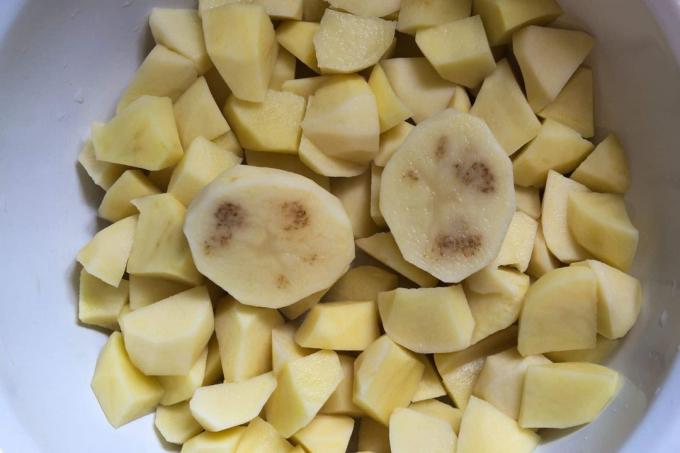
Potato is brown inside: is it edible?
After peeling or cooking, a potato has brown to black spots on the inside. This doesn't look very appetizing at first. And above all, the question arises as to whether the potato is still suitable for consumption or not. Since the causes of this discoloration can vary, in some cases it is due to […]

Black spots on potatoes: still use them?
Potatoes can have black spots. The potatoes are almost always edible despite the black spots. However, affected potatoes may show changes in taste and texture.
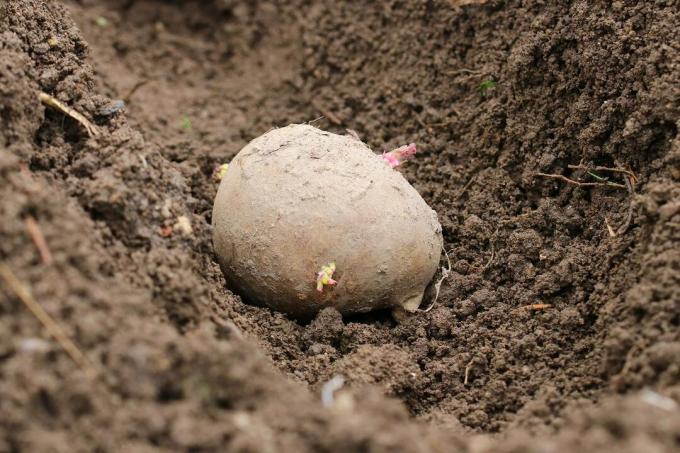
Time: from and until when do you plant potatoes?
Potatoes are among the most widely grown vegetables. So that self-cultivation works and a lush harvest can be brought in over many months, self-cultivators should pay attention to one important point: the right time to plant.

Planting potatoes: distance and depth
The potato (Solanum tuberosum) is a staple food with a wide range of preparation options. The tubers are indispensable in many dishes and are tastiest when you pick them yourself. What could be more obvious than growing them yourself. You can do this without your own garden.
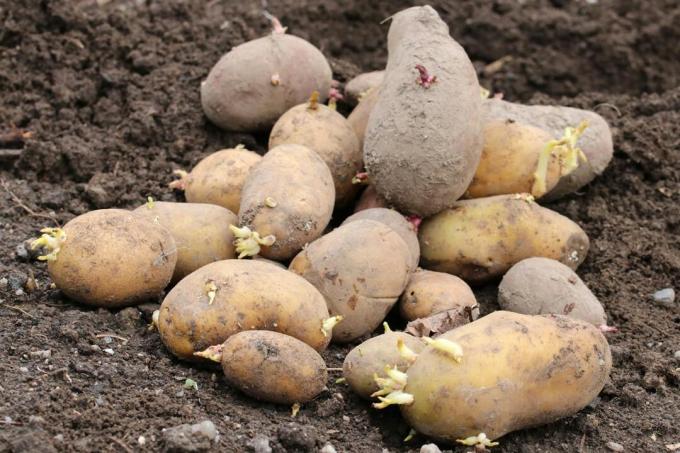
Mixed culture: 14 good neighbors of potatoes
German cuisine would be unthinkable without potatoes. Have you ever thought about growing the delicious tubers in your own garden? Use the advantages of a mixed culture! We present 14 plants that are suitable for mixed cultivation with potatoes.

Laying potatoes: ideal spacing and depth
Potatoes are good for the vegetable garden because they prepare the soil optimally for subsequent vegetables. They can also be stored for a long time and can be prepared in a variety of ways. You can read here which spacing is the right one for laying potatoes.
